An overview of the very best early grape varieties: descriptions, characteristics and taste
Of course, now you can't surprise any with early grapes, which give a full harvest in the second half of summer. But breeding has achieved such impressive results not so long ago. However, now another more important question arises before summer residents - what kind of early, and better over or very early, grape variety to choose for their site so that it fully meets all the requirements and expectations (in terms of yield, taste, resistance to diseases, agricultural cultivation ).
Worth knowing! As a rule, in terms of ripening (the duration of the growing season - from budding to full ripeness of berries), all grape varieties are divided into the following 8 groups:very early (up to 105 days), very early (105-115 days), early (115-125 days), early middle (125-135 days), medium (135-145 days), medium late (145-155 days), late ( 155-165 days) and very late (165 or more days).
Next, we will focus on the best grape varieties, divided by color (white, pink, black), which are exactly in the first 3 groups, i.e. these are very early, very early and early.

Content
The best early white grapes: top 7
Among white grape varieties, the following best representatives of the grape culture (in alphabetical order) belong to the category of very early, very early or simply early grape varieties:
Aisar
Obtained by crossing the Talisman and Richelieu varieties, breeding VNIIViV them. Ya.I. Potapenko.
Bushes above average vigor, vigorous one might say.
The clusters are large, conical, of medium density, the average weight of a cluster is about 600 g.

The berries are white, oval in shape (from round to almost cylindrical), the average weight is 11-16 g. The pulp is firm, juicy and fleshy, the taste is very pleasant (sweet) harmonious.
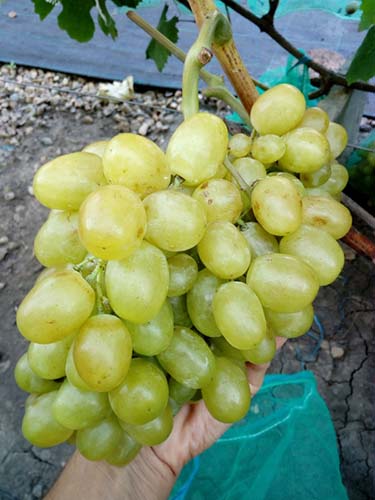
The taste is very similar to the Super-Extra variety.
Characteristics of the Aisar variety:
- ripening period - 105-115 (very early);
- the percentage of fruitful shoots - 75-85%;
- fruiting coefficient - 1.4-1.6;
- sugar content - 17.9-23.2 g / 100 cm3;
- acidity - 4-5 g / dm3;
- frost resistance up to -23 degrees.
Advantages:
- High tasting score (8.6 points).
- The flower is bisexual.
- Relative resistance to mildew (3.5 points).
- Excellent transportability and marketability.
- Stores well, even the stalk does not dry out.
If the crop is underloaded, it can yield crops on stepchildren.
Disadvantages:
- Mandatory rationing of the yield is required (on each shoot, 2-3 inflorescences).
- Unstable to powdery mildew.
Aleshenkin (Alyosha)
The variety was obtained by crossing Madeleine Angevin and a mixture of oriental pollen. Volgograd selection.
Medium and vigorous bushes.
Forms large brushes of a loose structure with a conical shape, with an average weight of 350-500 g (maximum up to 2 kg).
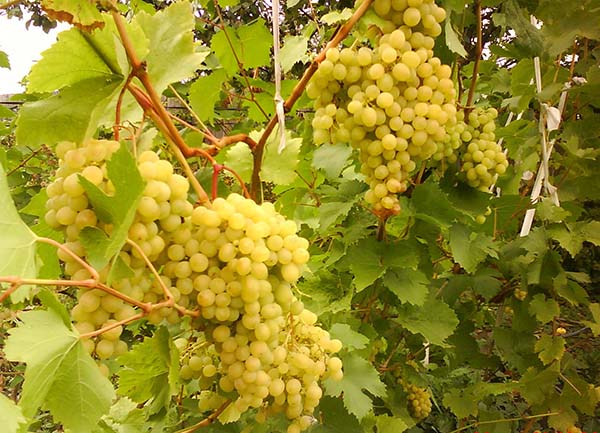
Has an amber hue with a white coating over the skin. Sufficiently small oval fruits, their weight reaches 3-5 g. The skin is thick. The pulp is crispy and juicy, with a pleasant sweet taste.
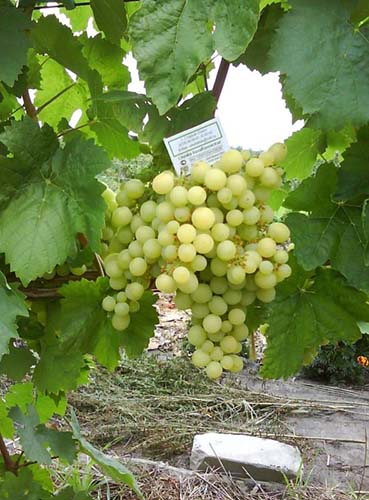
The main characteristics of the Aleshenkin variety:
- ripening period - 100-120 days (very early or very early);
- yield - 8-10 kg per bush.
- acidity - 3-6 g / l;
- sugar accumulation - up to 17-20%;
- eye load - 30-40;
- the recommended pruning is for 8-10 eyes (but you can also for a short one - 5-6 eyes).
- frost resistance up to 22 ..- 26 degrees.
Benefits:
- Very high tasting score (8.8 points).
- Consistently high yield.
- Amicable ripening of berries.
- Flowers are bisexual.
- High percentage of rooting cuttings.
Disadvantages:
- Susceptible to fungal diseases.
- Prone to peas.
- Ripening of the vine is satisfactory.
- It is prone to overload, therefore, it requires mandatory rationing (1 brush per 1 shoot).
Bazhena
A hybrid form of grapes, obtained on the basis of the species qualities of Arcadia and the Gift to Zaporozhye. Selections V.V. Zagorulko (Ukraine).
The variety forms vigorous bushes.
The brush is large, conical or cylindro-conical, sometimes branched, of medium density. The mass of a bunch is on average 700 grams (maximum - up to 1.5 kg).
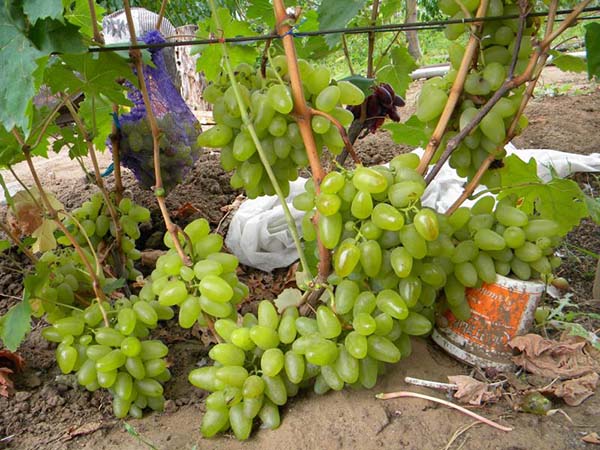
The fruits have a light green-amber uniform hue. The berries are large (42 by 23 mm), but they are nipple-shaped and ovoid - 35 by 27 mm, weighing up to 20 grams. It has a harmonious taste with a light fruity aroma (from cherry to apple, depending on sugar accumulation). The pulp is juicy and fleshy, the skin is thin.
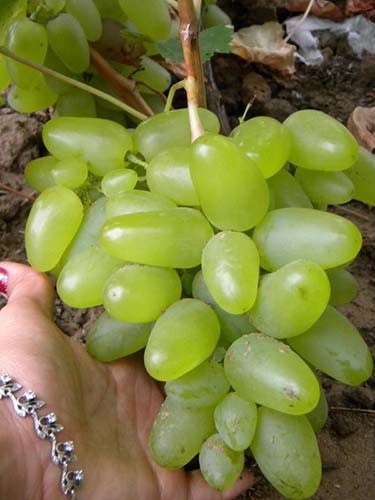
Characteristics of the Bazhena variety:
- ripening period - 105-115 days (very early);
- sugar accumulation (sugar content) - 15-16%;
- acid level (acidity) - 4-6 g / l;
- the load of the eyes on the bush is 25-35;
- it is optimal to do an average cut of 6-8 eyes (but you can also cut it short);
- frost resistance up to -21 ..- 24 degrees.
Advantages:
- High-yielding variety.
- The flowers on the plant are bisexual, which contributes to a stable ovary.
- Ripening of shoots is good.
- The cuttings root perfectly.
- Marketability and transportability are high.
- Relative resistance to mildew and powdery mildew (3-3.5 points).
Disadvantages:
- Sometimes it is affected by wasps.
- The tip of the berry may crack (with frequent rains).
Delight White (Delight)
This variety is obtained by combining the qualities of Zori Severa and Dolores, as well as Russian early. Breeding VNIIViV them. Ya.I. Potapenko (Russia).
Bushes are medium to vigorous.
By the way! It has established itself well as an arched culture, i.e. can be grown on gazebos.
The bunches can be shapeless, or they can take the shape of a cone, their weight varies within 600-800 g (maximum up to 2 kg), depending on the cultivation technique.
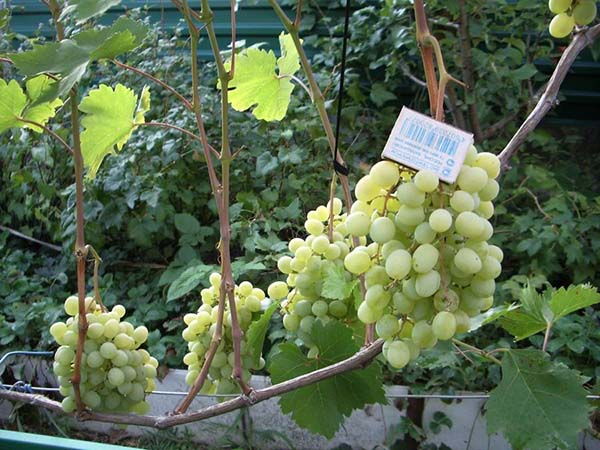
The fruits have a light creamy shade with a slight blush on the skin from the sunny side. The fruits are large, their weight is 5-8 g. The taste is harmonious. It has a crispy, dense pulp with a thin skin, which is almost imperceptible when consumed (eaten).
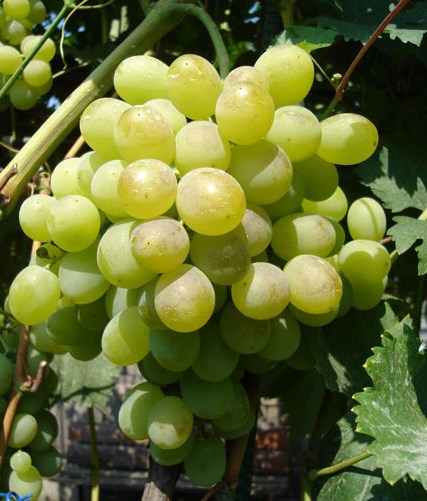
The main characteristics of the White Delight variety:
- ripening period - 110-115 days (very early);
- sugar ratio - 19-26%;
- acid content - 5-9 g / l;
- the rate of fruitful shoots is 65-85%;
- the number of clusters per shoot - 1.4-1.7;
- the optimal load of the eyes is 35-45;
- trimming can be 6-10 eyes (but you can also trim 2-4);
- frost resistance up to -25 degrees.
Advantages:
- The tasting indicator is 8.6 points.
- Differs in bisexual flowers.
- Relative resistance to mildew (3-3.5 points) and high - to gray rot (2 points).
- Very good maturation of the vine.
- It can hang on the vine for a very long time and not deteriorate (up to 1-1.5 months).
- The cuttings take root quickly.
- Wasps are not damaged.
- Does not lose its commercial qualities during transportation.
Minuses:
- May be sick with powdery mildew.
- Susceptible to phylloxera.
- Needs vigorous rootstocks.
Laura (Flora)
The species was obtained by crossing a mixture of pollen from Muscat Hamburg and Husayne, Muscat de Saint-Vellier, Queen Tairovskaya and a mixture of pollen from Central Asian varieties. Selection IV&V them. V.E. Tairova (Ukraine).
Laura is a medium or vigorous bush that is poorly pinned, but when pinching it is necessary to leave 1-2 leaves, otherwise the buds intended for growth next year will start to grow.
Forms conical clusters of predominantly loose structure weighing up to 1 kg (on average 600-800 grams).
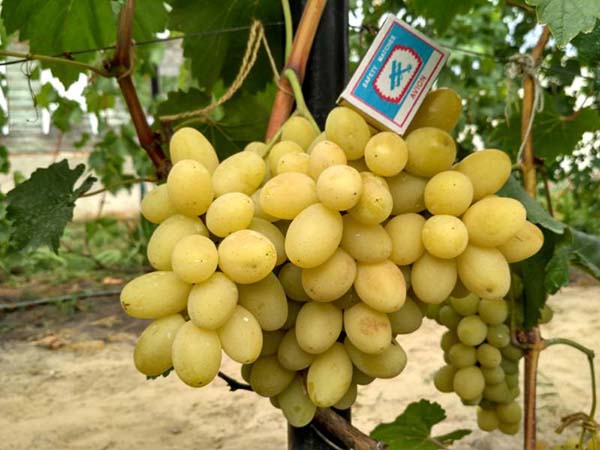
The color is light green with white prune; in the sun, the fruits acquire a light tan. The berries are either cylindrical or oval, sizes - 30 by 22 mm, weight - 6-10 g. The flesh is crispy, the seeds are large. The rind is firm but thin. The fruits are firmly attached to the stalk, so the bunches do not crumble. The taste of grapes is unobtrusively pleasant (accentedly oriental).

Characteristics of the variety Laura (Flora):
- ripening period - 110-115 days (very early);
- sugar accumulation - about 20% or more (up to 23%);
- acidity - 5-8 g / l;
- the number of fruitful shoots - 60-80%;
- the number of bunches per fruitful shoot - 1.3-1.5;
- eye load - 40-50;
- vines can be cut medium by 5-6 eyes or short by 2-4.
Note! The variety is not picky about care and is flexible to climatic conditions.
Benefits:
- High tasting score (8.9 points).
- Flowers are predominantly female, but pollinated well and the ovary occurs evenly.
- Good vine maturation.
- Cracking of the fruit is extremely rare.
- Relative resistance to mildew (3 points).
- Not affected by gray mold.
- High resistance to phylloxera.
- Not peas.
- Can hang on bushes for a long time and accumulate sugar.
- Not damaged during transportation.
- Excellent marketable berry.
Advice! The use of gibberellin lengthens the berries and produces seedless grapes.
Minuses:
- Sometimes it is affected by powdery mildew.
- Berries, due to the high percentage of sugar, are often damaged by wasps.
By the way! If you use vigorous rootstocks, you can achieve larger berries, but the ripening period will slightly increase and sugar accumulation will decrease.
Super Extra (Citrine)
The grape variety obtained by crossing the Cardinal with a mixture of pollen and Talisman. Amateur selection E.G. Pavlovsky.
Forms vigorous plants.
The size of the clusters is large, and their average weight is 500-800 g (up to 1 kg). The shape can vary from conical to cylindro-conical with or without one wing, and the structure is medium dense or loose, depending on the conditions during pollination.
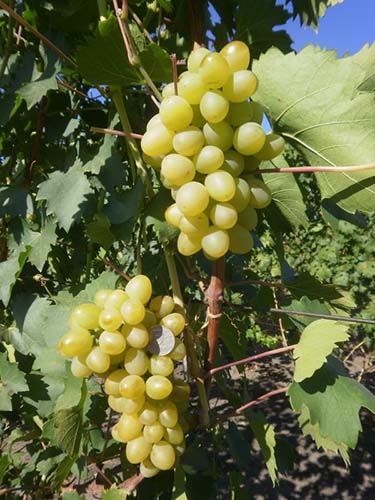
The berries are light green in color with a golden sheen. Super Extra's fruits are round (egg-shaped), large in size (size 25 by 21 mm) and weighing 7-13 g. Their taste is harmonious (light nutmeg aroma), the pulp is juicy and dense (fleshy), the rind is medium thick.
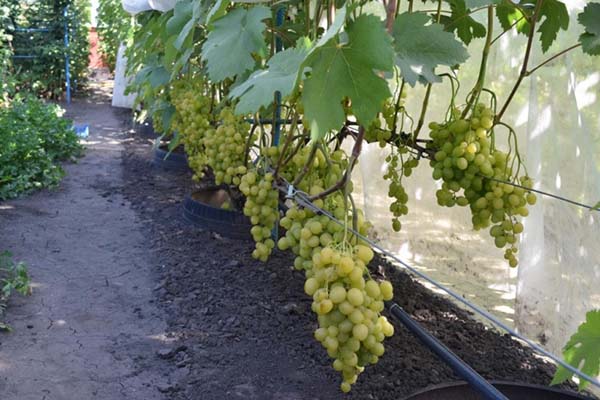
Characteristics of the Super Extra variety:
- ripening period - 100-110 days (very early or very early);
- sugar accumulation - 10%, but sometimes 16-19%;
- acid content - 5-6 g / l;
- frost resistance up to -23 ..- 25 degrees.
Important! Super Extra is prone to peas, so it is recommended to pinch before flowering, and you should not thicken the plantings so that the fruit zone is well ventilated.
Advantages:
- High and stable yield.
- Differs in bisexual type of flowers.
- It persists for a long time on the bushes.
- The vine ripens perfectly.
- Has a decent presentation.
- Not afraid of transportation.
- Resistance to mildew is high, to powdery mildew - medium.
Minuses:
- Prone to peas.
- Unstable against gray mold.
- It is prone to overload, therefore it is necessary to normalize.
- It is unstable to phylloxera.
Timur
When crossed, the hybrid absorbed the best qualities of the Frumoas Albe and Delight varieties. Breeding VNIIViV them. ME AND. Potapenko (Russia).
Forms a weak and medium vigor of plant growth, therefore it is not recommended to plant with vigorous crop species.
Forms cylindro-conical or simply conical clusters weighing 400-600 g, their structure varies from moderately loose to moderately dense.

The fruits are white-amber in color with a slight brown tan. Timur's berries are large, 29 by 21 mm in size, resembling an oval in shape with a pointed tip (nipple), weighing 6-9 grams. The pulp is crunchy, with harmonious taste, in which there is a slight nutmeg hue, but more often the taste is rather tart. The peel of the fruit is thin, torn, not perceptible when consumed.
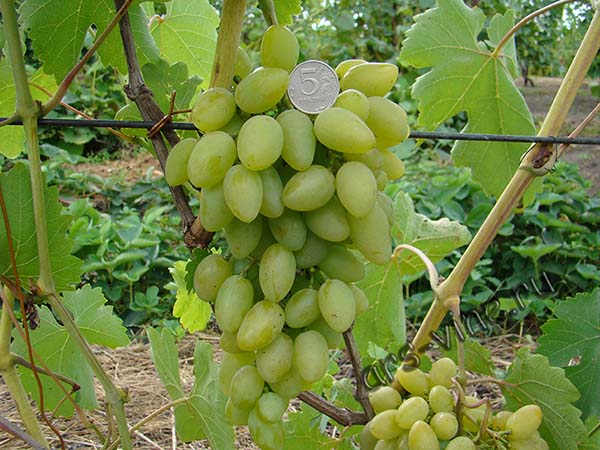
Characteristics of the Timur variety:
- ripening period - 105-115 days (very early);
- sugar content - 17-22%;
- acid content - 6-9 g / l;
- fruitful shoots - 80-90%;
- the ratio of bunches per shoot is 1.5-2;
- optimal load - 30-40 eyes;
- pruning shoots can be used as long - for 8-12 eyes, and short - for 2-4;
- frost resistance up to -25 degrees.
Note! Growing Timur on vigorous rootstocks has a positive effect on the quantity and quality of the crop, but at the same time the ripening of fruits slows down.
Pros:
- Has bisexual flowers.
- Easily propagated by cuttings.
- Begins to bear fruit quickly.
- High index of resistance to mildew and gray rot.
- Good vine maturation.
- It can hang until it gets cold (with almost no sugar loss).
Minuses:
- Peas happen.
- Wasps are often interested.
- Poorly tolerates transportation.
Other very early white varieties
Also among the ultra-early white grape varieties loved and respected by many experienced growers include:
- Alma-Ata early;
- Amatea;
- Valerie;
- Harold;
- Dovga;
- Olympics;
- Moscow early.
Note! if you not necessarily need very early grapesbut you want exactly whitethen we advise you to look here (article on the best white grapes).
The very best early pink white grapes: top 12
Naturally, among the pink grape varieties there are excellent very early, very early or just early representatives of the grape culture (alphabetically):
Azalea
The variety is obtained by a complex crossing of Nadezhda Aksayskaya, as well as a mixture of pollen from Delight red and Taifi resistant. Amateur selection Kapelyushny V.U.
The bushes are medium-sized.
Forms large clusters of medium-friable structure, which are distinguished by a short peduncle. The average weight of one grape cluster is 700 grams (maximum 1-1.2 kg).
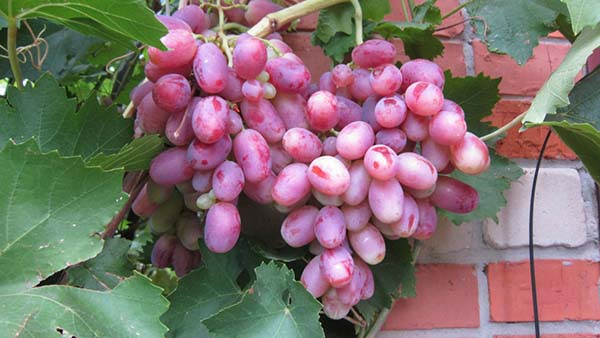
Fruits of uniform light pink color. Azalea berries are large, 34 mm long, 25 mm wide, reminiscent of an oval, each weighing 10-14 g. The pulp of the fruit is juicy, fleshy, with a thin skin, which is not noticeable when consumed.
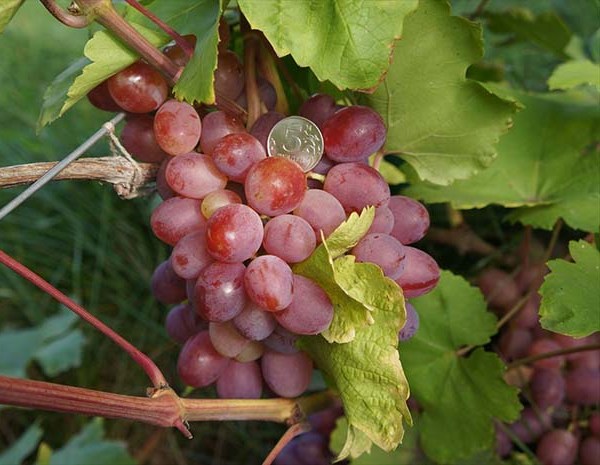
Special features of Azalea:
- ripening period - 105-120 days (very early or very early);
- sugar accumulation - 21-23%;
- acidity - 5-6 g / l;
- eye load - 25-35;
- it is optimal to do an average pruning of 6-8 eyes;
- frost resistance up to -25 degrees.
Advantages:
- It has bisexual flowers, which gives stable pollination.
- High productivity.
- Not prone to peas.
- Not damaged in transit (excellent transportability).
- High resistance to mildew, gray rot and powdery mildew (2-2.5 points).
- High survival rate of cuttings.
Disadvantages:
- Yield adjustment required.
- Strong rootstocks are required.
Victor
Bred by amateur winegrower V.N.Krainov (Transfiguration and Jubilee of Novocherkassk are also his varieties).
The variety is medium or vigorous.
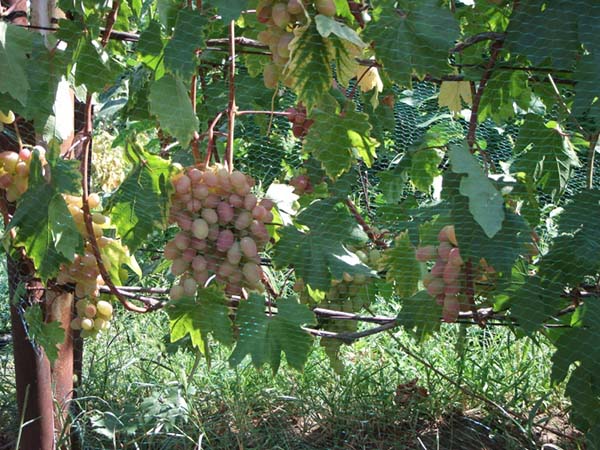
Grape clusters are large (up to 2 kg) or medium in size, weighing 500-1000 grams, medium density.
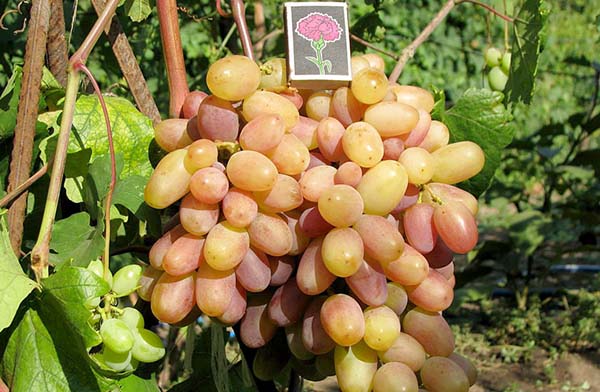
The color changes as the fruit ripens from pink-amber to red-lilac. Fruits in the form of an elongated oval with a pointed end. Very large, their weight is about 9-15 g (maximum up to 20 grams), and their length is about 50 mm. The taste is pleasant, the pulp is fleshy and juicy, with an average density. The Victor variety has a thin edible rind.
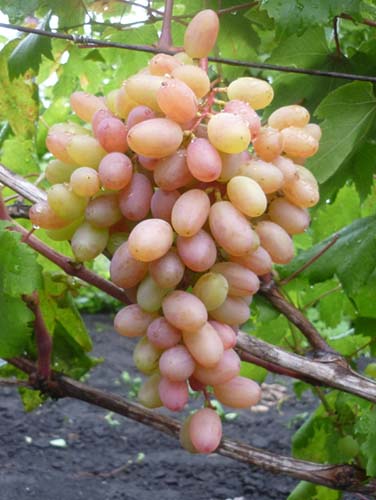
Characteristics of the Victor variety:
- ripening period - 100-110 days (very early or very early);
- sugar content - up to 17 g / l;
- acid content - 8 g / l;
- the maximum load of the eyes is 30-40;
- trimmed into 8-10 eyes;
- frost resistance up to -23 degrees.
Advantages:
- Bisexual flowers.
- Yield stability.
- Not prone to peas.
- Shoots ripen well.
- Excellent presentation.
- Good resistance to common fungal diseases (mildew, oidium, gray mold).
By the way! Victor forms many stepchildren, which makes it possible to get a second crop on new shoots.
Disadvantages:
- Very early flowering period, which increases the likelihood of damage to inflorescences in the event of late spring frosts.
- Attractive to wasps.
- It is necessary to graft on vigorous rootstocks.
Early gourmet (Novocherkassky Red 1-12)
A variety of amateur breeding Krainova V.N., obtained by crossing the varieties Talisman and Kishmish radiant.
Bushes above average vigor. The flower is functional and feminine.
The bunch is cylindro-conical, medium density, large, weighing 500-900 g (individual up to 1.2-1.3 kg).
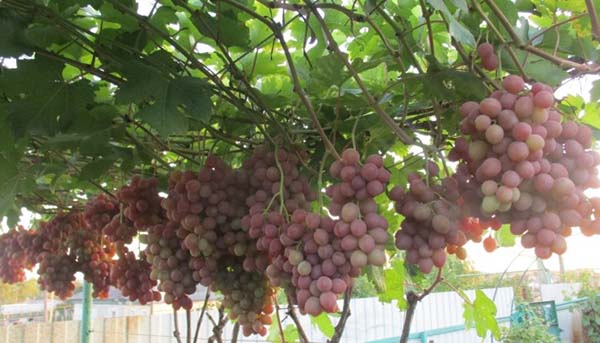
The berry is pink, oval, large, weighing 7-9 g. The taste of nutmeg is very bright, the flesh is fleshy and juicy. Eatable peel.
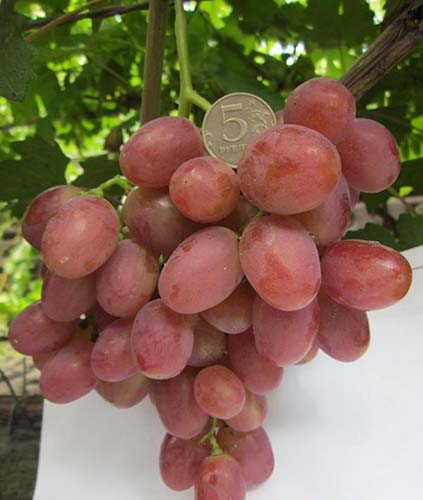
Characteristics of the early Gourmet variety:
- ripening period - 115-125 days (early);
- recommended load with eyes - 30-35;
- pruning vines - 6-8 eyes;
- frost resistance up to -23 degrees.
Advantages:
- Shoots ripen well.
- Wasp is hardly damaged.
- High transportability and marketability.
- Increased resistance to mildew and gray mold, medium to powdery mildew.
Disadvantages:
- Requires rationing of the load of fruits and shoots (otherwise the taste will deteriorate).
Kishmish Veles (Veles)
Seedless hybrid form of culture, bred by crossing the varieties Sofia and Rusbol. Selections V.V. Zagorulko (Ukraine).
Note! Veles is almost identical to Radiant Kishmish (in terms of yield, partly in the taste of pulp, color of berries), the whole difference is in the ripening period.
Differs in vigorous bushes.
Bunches at Kishmish Veles are formed in the form of a wide cone, branched, with an average density. Grape clusters reach a mass of 900-1700 g, and in some cases - up to 3 kg.

The fruits are pink with an amber tint. Berries are oval, weighing 4-5 g. Sweet taste, with an unobtrusive nutmeg aroma. The pulp is firm and crispy. The rind is thin, slightly palpable when consumed.
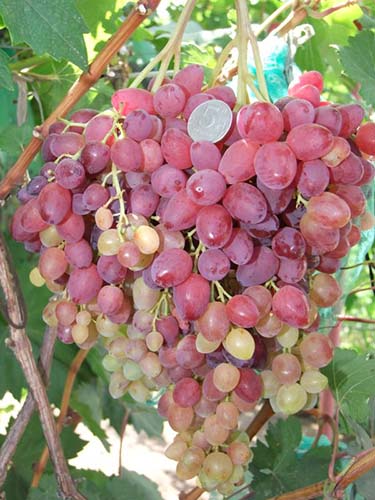
Characteristics of the Veles variety:
- ripening period - 95-105 days (very early);
- requires medium pruning of up to 6 eyes, but can be cut short.
- frost resistance up to -21 degrees.
Benefits:
- High yield, just gigantic brushes.
- Flowers are bisexual.
- Shoots ripen well.
- Suitable for long-term storage.
- Average resistance to mildew and powdery mildew (3.5 points).
There is also a stepchild's harvest on the bushes.
Disadvantages:
- After the rains, some of the berries crack.
- The bunches must be shortened, otherwise the color of the bunch is uneven.
- Often affected by gray rot.
Libya
The hybrid was bred by crossing based on the main qualities of the Flamingo and Arcadia varieties. Breeding "Magarach" (Ukraine), V.V. Zagorulko.
Forms vigorous plants.
The bunches of Libya are large, 25 cm or more long, cylindrical, moderately loose.

It has an uneven color - from light pink to saturated when the bunch ripens. The size of the berries is 28 mm by 18-20 mm (oval or ovoid), weight is 10-15 grams. The pulp is fleshy and juicy, the rind is not felt during use. Each berry contains no more than 1-3 seeds, which are easily separated. Libya is characterized by a pleasant taste with a nutmeg hue. The aroma lasts for 30 days during storage.

Characteristics of the variety Libya:
- ripening period - 105-110 days (very early);
- sugar accumulation - 20-25%;
- acidity - 6-7 g / l;
- the ratio of fruiting shoots is 70-80%.
- pruning shoots is recommended for 2-6 eyes.
- frost resistance up to -21 degrees.
Benefits:
- Stable yield.
- The flowers on the plant are bisexual, which guarantees a stable ovary.
- Shoots ripen perfectly.
- Excellent transportability.
- Good marketability.
Important! Saplings grow better on their own roots than on a scion.
Minuses:
- Very average resistance to powdery mildew (3.5-4 points).
- Uneven color of berries.
- Poor vine ripening at the slightest overload.
Transformation
A hybrid of grapes obtained as a result of amateur selection by V. Krainov.
Vigorous plants with a high degree of formation of stepsons.
Forms mainly shapeless and conical clusters weighing 700-1500 grams.
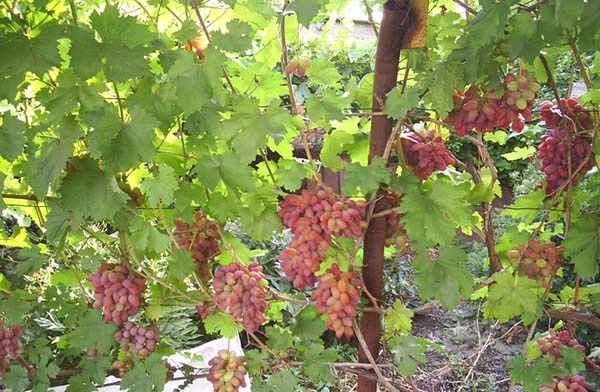
The color of the berries is from intense pink to red, more often the color is amber-pink, of an uneven color. Fruits are large, oval-elongated, weight reaches 10-14 g. Taste qualities are harmonious. The flesh of the Transfiguration is fleshy, the skin is medium dense, but not perceptible when consumed.

Characteristics of the Transfiguration variety:
- ripening period - 105-110 days (very early);
- sugar content - 17-19%;
- acid ratio - 6-7 g / l;
- the load of the bush with shoots - up to 30-35;
- optimal pruning by 6-8 eyes, but a good result is also obtained by pruning by 2-4 eyes;
- frost resistance up to -23 degrees.
Benefits:
- Has bisexual flowers.
- Good resistance to gray mold.
- Very high transportability and marketability.
- There is a possibility of re-harvesting on stepchildren.
- No peas.
- Good maturation of the vine.
Disadvantages:
- Very average resistance to common fungal diseases: mildew and oidium (3.5-4 points).
- Attracts wasps.
- Load rationing is required.
Important! Does not tolerate close proximity to trees and shrubs.
Rumba
Bred by crossing the Red and Charrel varieties. Amateur selection of Kapelyushny V.U.
Bushes of medium vigor. The flower is bisexual.
The bunches are large, cylindrical-conical, loose or of medium density, weighing 470-900 g or more, measuring 20-30 cm by 10-12 cm.
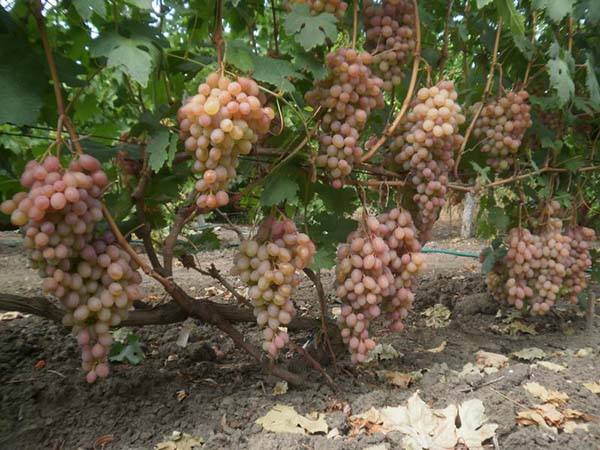
The berries are pink (bright red when fully ripe), very beautiful and large, 32 by 24 mm in size, nipple-shaped, weighing 8-10 g or more. The pulp is fleshy and juicy, sweet, with a pleasant aroma.
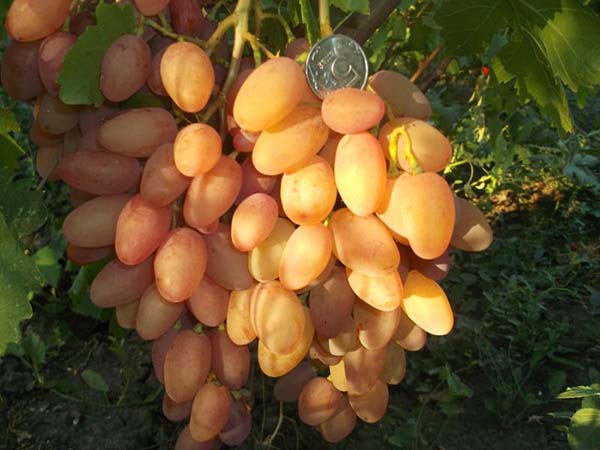
Characteristics of the Rumba variety:
- ripening period - 85-95 days (very early), according to other sources - 95-115 days (very early);
- load on the bush - 40-45 eyes;
- trimming - for 8-10 eyes;
- frost resistance up to -25 degrees.
Advantages:
- The yield is high and stable.
- It has very good commercial qualities and appearance.
- Transportability at altitude.
- Rootstock compatibility is good.
- The cuttings root very well.
- No peas.
- High resistance to mildew, oidium, gray rot (2 points).
Prone to the formation of a second stepchild's harvest.
Disadvantages:
- Some people think that the taste is too rustic (only sweet, without notes of anything).
Russian early
Obtained by crossing the varieties Shasla Severnaya and Michurinets. Breeding VNIIViV them. ME AND. Potapenko (Russia).
Bushes are medium and vigorous. The flowers are bisexual.
The clusters are medium, 200-400 g, conical, of moderate density and loose.
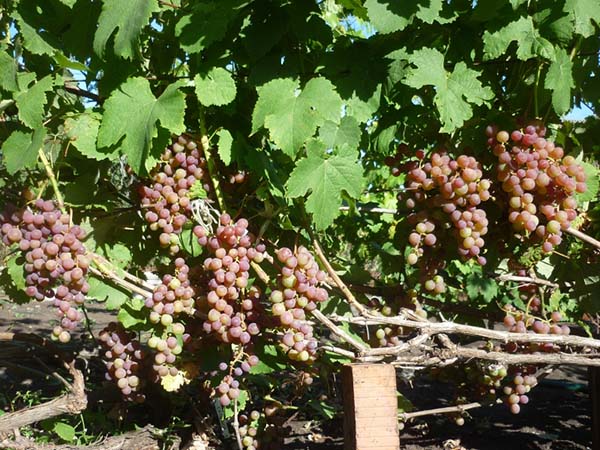
Fruits are dark pink. The berries are medium and large (medium size - 21 by 23 mm), round, weighing 3-5 g. The flesh is crispy, sweet, simple but harmonious taste, without any aroma.
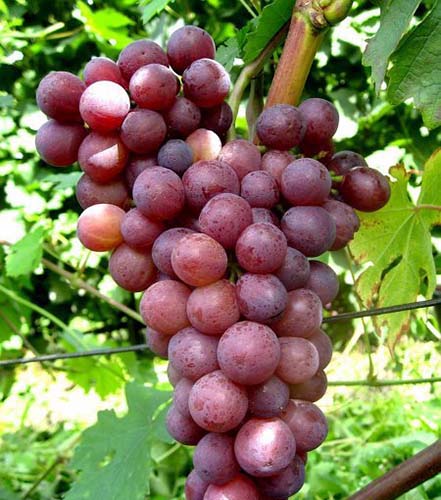
Recommended for growing in film and glass greenhouses.
Characteristics of the Russian early variety:
- ripening period - 105-115 days (very early);
- sugar content - 17-21%;
- acidity - 6-7 g / l;
- frost resistance up to -23 degrees.
Advantages:
- relatively resistant to mildew, gray rot, powdery mildew;
- shoots ripen well;
- very productive and not afraid of overload;
On a fruitful shoot, often 2-3 inflorescences.
- transportability and marketability are good.
Disadvantages:
- Wasps, ants, copperhead beetles and even butterflies often attack.
- Taste without aroma or aftertaste of anything, just very sweet.
Sensation
A hybrid crossed based on the Talisman and Rizamat varieties. Breeding Kapelyushny V.U.
It is characterized by high vigor of shoot growth.
Possesses high decorative and taste qualities. The sensation forms clusters of large size, conical shape, weighing 700-1500 g. Their structure can be medium-dense or loose.

Berries of a yellow-pink hue with crimson. Large fruits have an unusual finger shape, the weight of one berry reaches 16-22 g. The taste is harmonious, and when ripe, nutmeg notes are added. The flesh of the fruit is juicy and fleshy, with a thin skin, imperceptible during use.

Characteristics of the variety Sensation:
- ripening period - up to 100 days (very early).
- optimal load - 40-45 eyes;
- pruning vines for 8-10 eyes;
- frost resistance up to -24 degrees.
Benefits:
- Differs in bisexual flowers, which guarantees pollination under all conditions.
- High productivity.
- Ripening of shoots is good.
- No peas.
- Wasps are practically not damaged.
- High resistance to major diseases: mildew, oidium and gray rot (2.0-2.5 points).
- High percentage of rooting cuttings.
- Marketability and transportability are high.
Minuses:
- The load on the bush must be normalized.
- Often there are problems with the color of the berry (very transparent).
Somerset Seedlis
One of the best seedless varieties for northern viticulture created in the USA.
Bushes of medium to strong growth.
Bunches are small and medium (weighing 100-200 g). Dense and cylindrical.
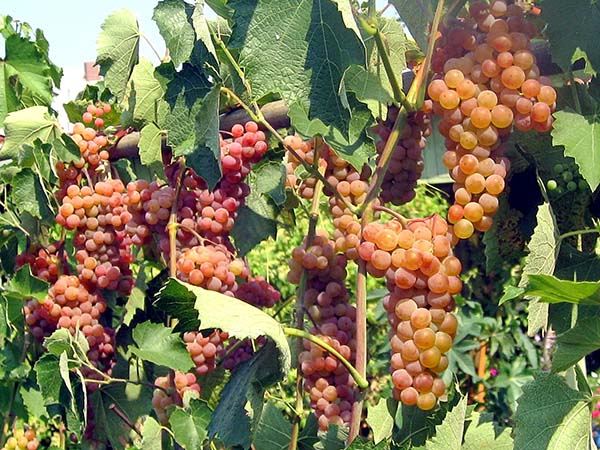
The berries are pink, small, round. The taste is pleasant, from strawberry-silk to caramel. Medium-density peel, firm, edible. Rudiments are sometimes found in fruits.

Somerset Seedles Variety Characteristics:
- ripening period - very early;
- any trimming is allowed (short, medium, long);
- frost resistance up to - 30-34 degrees.
- Very high frost resistance.
- Great taste.
- Excellent vine maturation.
- Comprehensive disease resistance.
- The yield is average.
- Very small clusters, or rather clusters.
Sofia
A hybrid form of grapes obtained by crossing Arcadia and Kishmish Luchisty, selection by V.V. Zagorulko (Ukraine).
Bushes are vigorous. The flower is functionally feminine.
The best pollinator for Sofia is Arcadia.
The bunches are large and very large, dense, weighing from 1 kg to 3 kg.
The berries are pink in color, large and very large (28-36 mm long, 20-21 mm wide), resembling the egg-shaped Arcadia variety. The skin of the berry is not felt when eaten. The pulp is fleshy and juicy, with a nutmeg aroma. The largest berries contain 1-2 seeds.
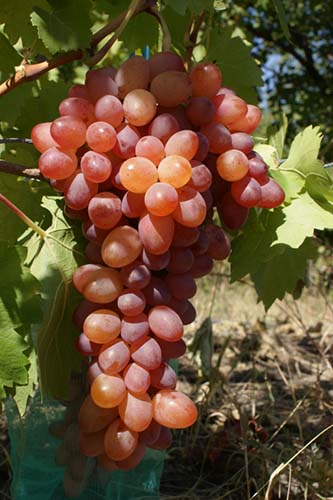
Characteristics of the Sofia variety:
- ripening period -110-115 days (very early);
- trimming - 4-8 eyes;
- frost resistance up to - 21 degrees.
Excessive nitrogen fertilization should be avoided.
Advantages:
- Very beautiful (marketable) type of bunches.
- Amazing taste.
- As a rule, the shoots ripen evenly and completely.
Disadvantages:
- Very average resistance to mildew and oidium (3.5-4 points).
- Prone to cross-pollination.
- The bunches are dense, therefore they require thinning of the berries.
- There are peas.
- May crack.
Julian
The hybrid was bred as a result of crossing Rezamat and Kesha varieties. Amateur selection Kapelyushny V.U.
When grown on its own roots, it forms vigorous bushes.
Differs in large grape clusters of medium friability with an elongated peduncle. The average weight of brushes is 300-500 grams, some are 1-2 kg.
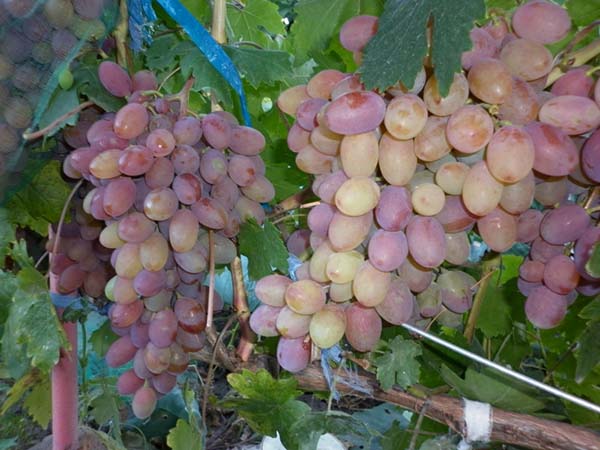
The fruits are very large, 8-12 grams each, the sizes are 40-42 by 26-28 mm, the shape is nipple. Taste qualities are harmonious: tasty and sweet (astringency may be present in the taste). The flesh is crispy, with a thin skin that is not noticeable when eating.
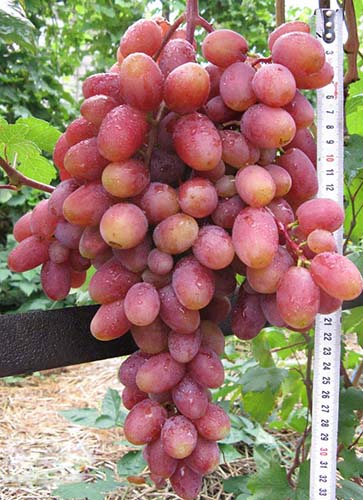
Characteristics of the Julian variety:
- ripening period - 95-105 days (very early);
- the optimal load on the plant is 40-45 eyes;
- the recommended pruning of the vine is 8-10 eyes;
- frost resistance up to -24 degrees.
Important! When grown on a scion, the quality of the fruit increases.
Advantages:
- Julian has bisexual flowers.
- High resistance to major diseases: mildew, oidium, gray rot (2.5-3 points).
- Not damaged by wasps.
- Roots well by cuttings.
- Excellent maturation of shoots.
- High percentage of compatibility with rootstocks.
- Excellent presentation and transportability.
Minuses:
- Correction of load is required (standardization).
There is a danger of overfeeding with nitrogen, in which case the berries will taste like grass ...
Other very early pink varieties
Also among the ultra-early pink grape varieties that are adored and respected by many experienced growers include:
Interesting! There is a lot of controversy as to which grapes are the varieties Zarya Nesvetaya and Gift Nesvetaya - pink or black. Some are classified as pink and others as black, as the berries in some regions often do not completely color and remain dark red rather than dark blue.
- Ayuta;
- Dawn Unsvetaya;
- Motley;
- Unlight's Gift;
- Rosemus;
- Tason.
By the way! You can read with other popular pink grapes in this detailed material.
The best early black grapes: top 9
Where can we go without black grapes, which is considered the most useful! Of course, among the black (blue) grape varieties there are excellent super-early, very early or just early representatives of the grape culture (in alphabetical order):
Academician (In memory of Dzheneyev, Academician Avidzba)
Obtained by crossing the varieties Gift Zaporozhye and Richelieu. Selection "Magarach" (Ukraine).
The bunches are large, cylindrical-conical, from loose to medium density. Weighing about 1 kg.
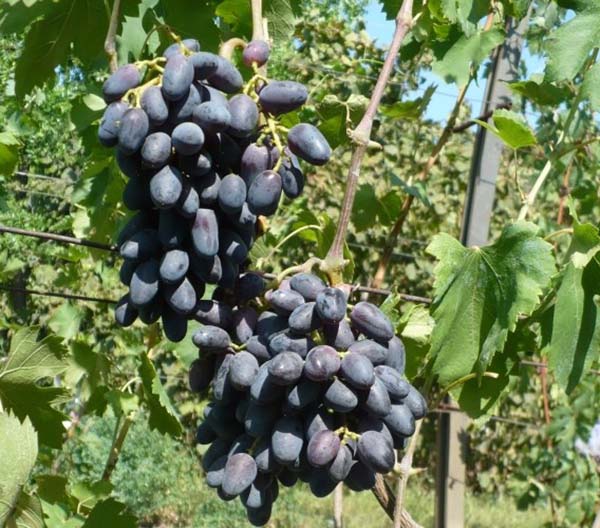
The berry is blue-black (dark blue), elongated-oval, measuring 33 by 20 mm. The skin is medium strength, the flesh is crispy. The taste is harmonious, dessert type.

Characteristics of the Akademik variety:
- ripening period - 100-115 days (very early or very early);
- average yield - 20-25 t / ha;
- frost resistance up to -23-25 degrees.
Advantages:
- Excellent tasting score (9.8 points).
- Resistance to fungal diseases (mildew and oidium) is average.
- High transportability.
- Withstands the most severe overloads.
Disadvantages:
- Interesting wasps.
- The first bunch on the shoot has peas, the second does not. Therefore, in the spring it is necessary to remove the first inflorescence.
- Sometimes there are problems with pollination.
Athos
A hybrid form of amateur grape selection V.K. Bondarchuk, obtained from crossing the varieties Talisman and Kodryanka.
Not a bad earlier alternative to Codreanca.
Bushes above average vigor. The flower is bisexual.
The bunch is conical, large, weighing 500-700 g, medium density.
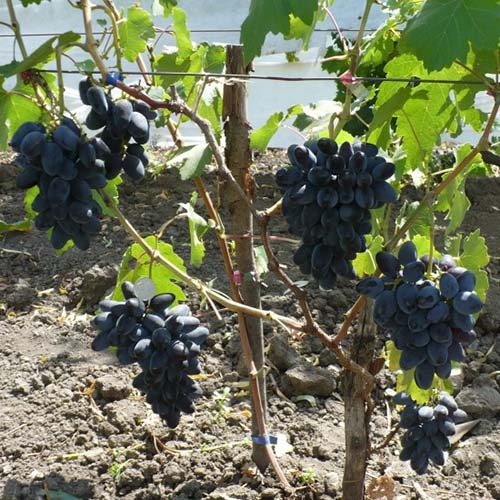
The berry is dark blue, oblong-ovoid, large, weighing 10-12 g. The skin is of medium thickness and density, the flesh is crispy, the taste is harmonious.
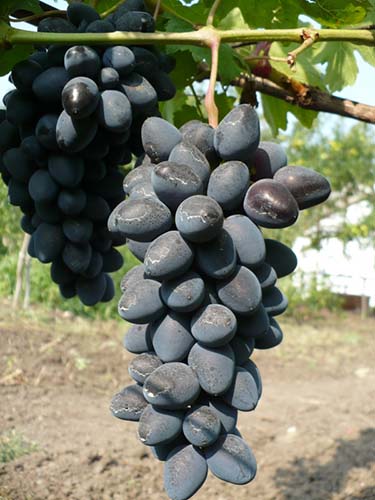
Characteristics of the Atos variety:
- ripening period - 95-100 days (very early);
- plant load with eyes - 30-35;
- pruning of fruiting vines is average - by 6-8;
- frost resistance up to -23 degrees.
Advantages:
- Increased resistance to fungal diseases (except for mildew).
- Ripening of the vine is excellent.
- Cuttings root very well
- No peas.
- Wasps are not damaged.
- Without loss of taste, it can hang on the bush for up to a month.
- High transportability.
Disadvantages:
- Often affected by mildew.
- Simple enough taste.
Viking
A hybrid form of culture, obtained by crossing on the basis of the qualities of Codryanka and ZOS-1 (Red Rapture). Selections V.V. Zagorulko (Ukraine).
Differs in a very strong growth of shoots.
Forms conical clusters weighing 600-800 g, in especially fruitful years up to 1000 g. Their structure is medium-dry.

Fruits of a deep dark blue shade with a waxy coating on the skin. The berries are distinguished by a dessert flavor and a light prune flavor. Fruit weight is 8-12 g, their shape is elongated ovoid (usually 22 mm x 34 mm). The pulp has a dense juicy structure, the eaten skin is slightly palpable when eaten.
The main characteristics of the Viking variety:
- ripening period - 100-115 days (over early or very early);
- sugar accumulation - 16%;
- acid content - 4-6 g / l;
- needs a long pruning of 12-14 eyes;
- frost resistance up to -21 degrees.
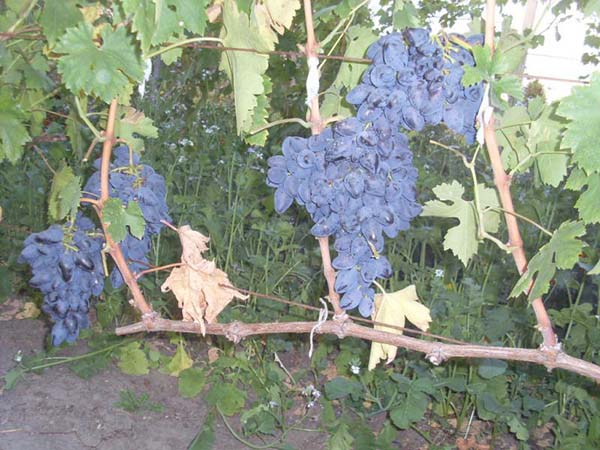
Benefits:
- Flowers are bisexual.
- It can hang on a bush and not deteriorate up to 1-1.5 months.
- High marketability.
- No peas.
- Good maturation of shoots.
- Resistance to major diseases: to mildew - 3.5-4 points, oidium - 3.0 points.
Disadvantages:
- With the enormous strength of the bush, low fertility and, as a result, poor productivity.
- Prone to cracking of fruits with increased soil moisture.
- Due to its very high growth force, it is prone to fattening and has problems with the setting of fruit buds.
Gala
The hybrid originated from the crossing of Kodryanka and Podarok Zaporozhye varieties. Selections V.V. Zagorulko (Ukraine).
The bushes are very vigorous.
Forms large cone-shaped grape clusters, their weight depends on agricultural technology and varies from 500 g to 1.5 kg.
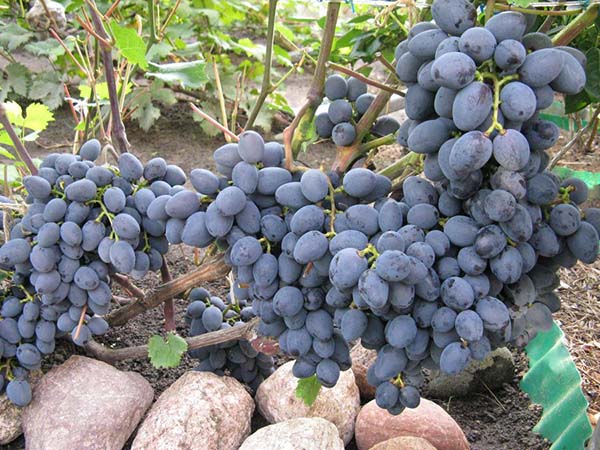
The structure of the bunches resembles the Black Delight grape variety.
The fruits are uniformly dark blue in color. The berries are oval, medium-dense, weighing from 7-10 g. It differs in crispy fleshy pulp, but the peel is almost imperceptible when consumed, the taste is quite simple (sweet and sour).
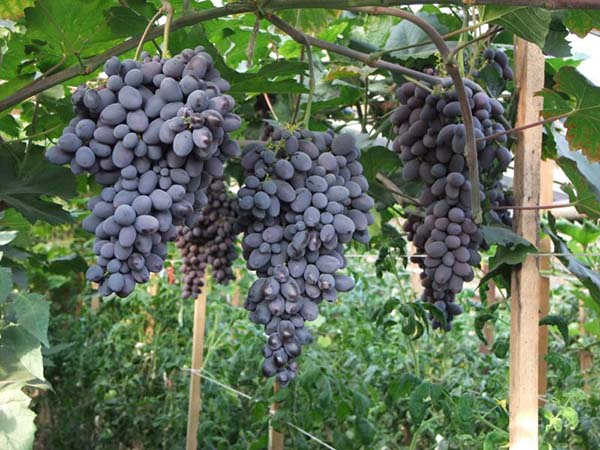
Characteristics of the Gala variety:
- ripening period - 110-115 days (very early);
- sugar ratio - 16.5%;
- acidity - 6-8 g / l;
- recommended load - 30-40 eyes;
- trimming - 6-8 eyes;
- frost resistance - up to -21 ..- 22 degrees.
Benefits:
- Tasting qualities - 8.6 points.
- The flower is bisexual.
- Resistant to fungal diseases: mildew, oidium, gray rot (3-3.5 points).
- Good transportability.
- No peas.
Disadvantages:
- It is necessary to normalize, otherwise (with overload) maturation is delayed (acid will not go away).
Fun
Derived from crossing the varieties Laura and Codryanka. Selections V.V. Zagorulko (Ukraine).
According to many winegrowers, it is quite a suitable replacement for Codreanca.
Growth vigor of own-rooted bushes is great, leaf shape, like Laura's. The flower is bisexual.
The bunches are large, moderately dense, with an average weight of 600-1500 grams.
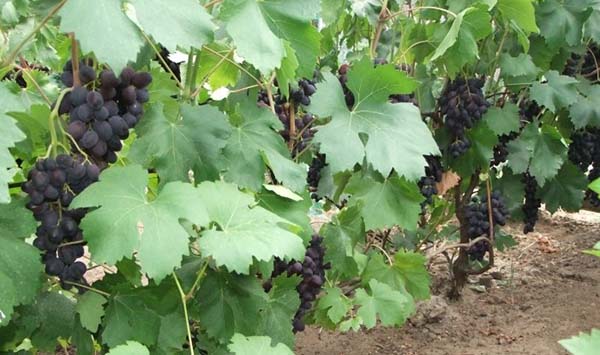
The berries are dark blue with a dense prune, large (7-12 g), oval-ovoid, with dense fleshy pulp of a harmonious taste (some call it "marmalade"). The berry contains 3-4 medium-sized seeds.

Characteristics of the variety Zabava:
- ripening period - 100-110 days (very early or very early);
- load on the bush - 30-35 eyes;
- pruning vines - 6-8 eyes;
- frost resistance up to -19-21 degrees.
Advice! To improve the quality of berries, green operations are necessary: removing weak shoots and all stepchildren, pinching the tops of fruiting shoots before flowering, rationing fertile shoots with extra inflorescences, removing leaves for good sun illumination of the bunch zone during the period of softening and ripening of berries.
Advantages:
- Wasps are not affected.
- No peas.
- Ripening of shoots is good.
- Cuttings root well.
- Compatible with most rootstocks.
- Disease resistance is average (3-3.5 points).
- The bunches have a very attractive presentation.
Disadvantages:
- It has a tendency to overload, so it is necessary to normalize the bushes with shoots and bunches.
Zilga
Note! The variety is universal (table and wine).
Bred on the basis of a complex crossing of the Smuglyanka variety with a mixture of pollen from Dvietes zila and Yubileiny Novgorod. Selections P. Sukatniek (Latvia).
Bushes are vigorous.
Note! The variety is great for gardening gazebos.
Brushes are cylindrical, large, weighing 320-400 g, often with a wing, generally have a dense structure, but sometimes they are loose.

It has a uniform dark blue color. Oval fruits are large in size, weighing 4.1-4.3 grams. The flesh is slightly slimy, with a slight isable aroma.
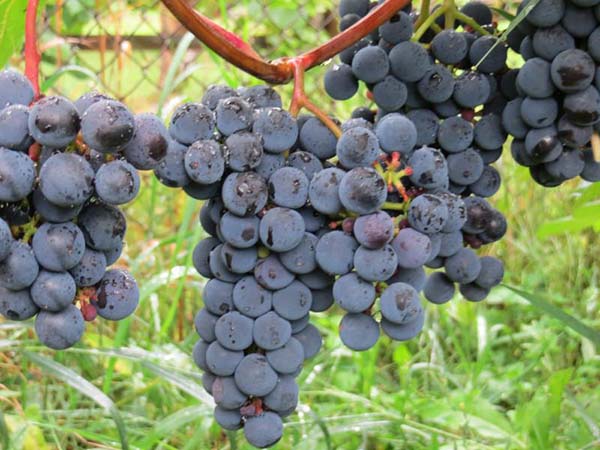
Characteristics of the Zilga variety:
- ripening period - 102-108 days;
- sugar accumulation - 18-22%;
- acidity - 4.5-5 g / l;
- the ratio of bunches is 1.5-1.9;
- shoots ratio - 80-85%;
- load - 30-40 eyes;
- optimal pruning of vines - 3-4 eyes;
- frost resistance up to -25 degrees.
Advantages:
- The crop is preserved for a long time on the bush without loss of quality.
- Resistant to major diseases (mildew, oidium and gray rot).
- Shoots ripen very well.
- Not damaged in transit.
- Compatible with different rootstocks.
Disadvantages:
- Average tasting assessment of the quality of fresh fruits (7.1 points).
Codryanka
The variety was bred by crossing the varieties of Moldova and Marshal. Breeding "Vierul" (Moldova).
It is characterized as a vigorous plant.
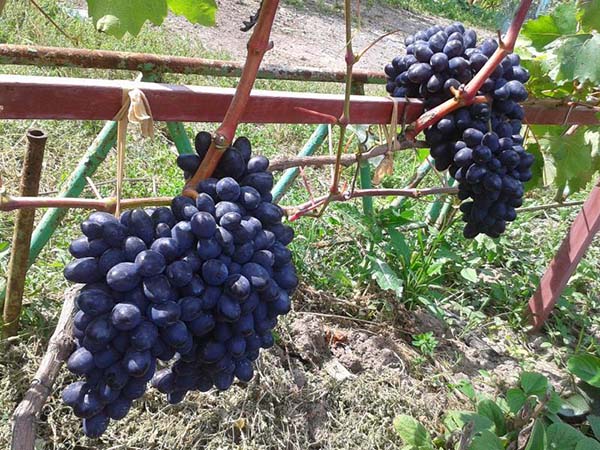
Grape clusters have an average weight of 400-600 g, but there are also individual ones up to 1200-1500 g. The structure is medium loose (moderately dense).
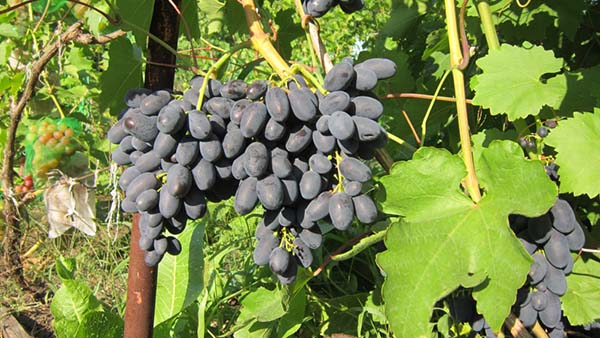
The berries are dark purple in color. Fruit weight - 6-8 g, shape - oval, average length - 31 mm, width - 19 mm. The taste is simple, but the flesh is crunchy, the easily separable bones and imperceptible rind, when used together, give a good tasting quality.
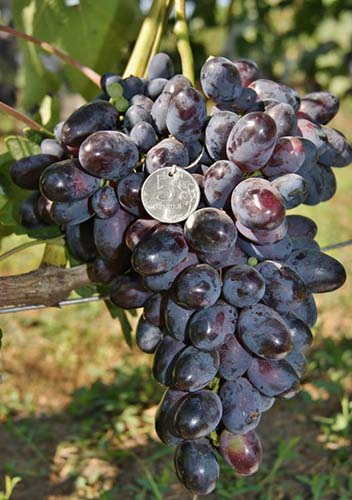
Characteristics of the Codryanka variety:
- ripening period - 110-120 days (very early or early);
- sugar accumulation - 18-19%;
- the ratio of acids is 6-7 g / l;
- fruitful shoots - 70-85%;
- the number of clusters per fruitful shoot - 1.2-1.7;
- the load on the bush during pruning is 40-50 eyes;
- trimming - for 8-10 eyes;
- frost resistance up to -22 - .. 24 degrees.
Note! Codryanka can be consumed even with incomplete accumulation of sugar in berries (12-14%), since this variety is characterized by a rapid decrease in acidity.
The advantages of the variety:
- Tasting score (8.2 points).
- Has increased resistance to gray rot, as well as to mildew and powdery mildew (3 points).
- Tolerant to phylloxera (grape aphid).
- Good maturation of shoots.
- It can hang on bushes for a long time without loss of taste.
- Excellent marketability and transportability.
- Weakly affected by wasps.
- Good keeping quality.
By the way! Responds well to gibberellin treatment.
Disadvantages:
- Possibly peas.
Important! It is rightfully one of the best, most popular and problem-free grape varieties.
Rochefort
A hybrid form of amateur selection, by a complex crossing of the Talisman variety and the Cardinal variety with a mixture of pollen.
Great strength of growth. With a bisexual flower.
The bunches are medium, loose, weighing 300-400 g (individual 1 kg).

The berries are dark blue, rounded, 21.5 by 20.5 mm, with an average weight of 6-7 g (some up to 13-17 grams), Good harmonious taste, the skin is eaten, the flesh is fleshy.
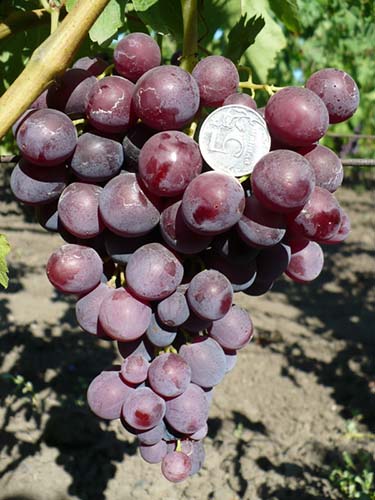
Rochefort characteristics:
- ripening period - 95-110 days (very early);
- sugar content of berry juice - 14.8 g / 100 cm3;
- acidity 5.6 g / dm3;
- frost resistance up to -15 ..- 18 degrees.
Advantages:
- Ripening of shoots is good.
- The berries can hang on the bush for a long time without cracking.
- The variety is not damaged by wasps.
- Has good resistance to mildew and gray mold.
Disadvantages:
- It is affected by powdery mildew.
Sphinx
The hybrid is bred on the basis of the Strashensky and Timur varieties. Selections V.V. Zagorulko (Ukraine).
It is characterized by great vigor of growth.
Forms large sheets of medium dissected shape.
Large grape clusters have a cylindro-conical shape with an average density, weighing up to 1 kg.
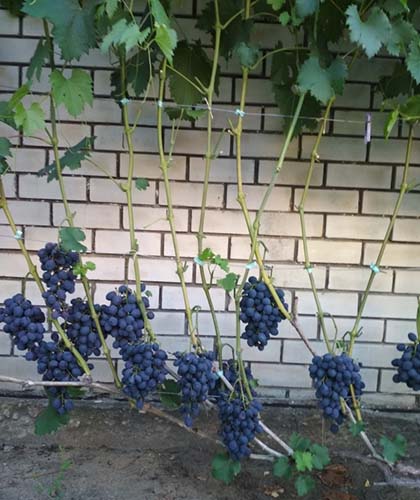
The size of the fruit is 28-32 mm (the shape can be oval or ovoid), weighing 6-9 grams. They are characterized by a crispy flesh with a firm rind, slightly palpable when eaten. Taste qualities are harmonious, there is a characteristic interesting varietal aroma.
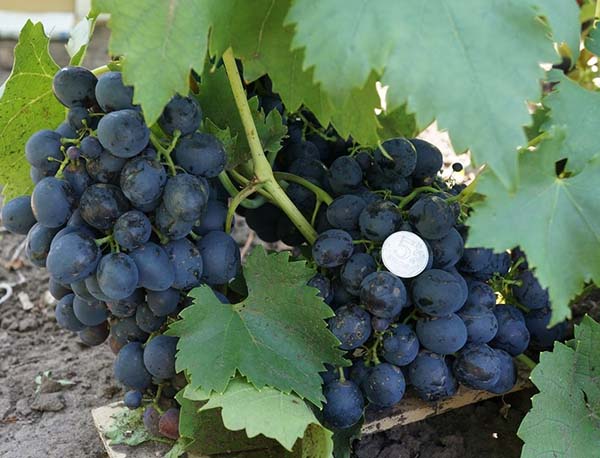
Characteristics of the Sphinx variety:
- ripening period - 100-105 days (very early);
- pruning vines is recommended for 4-6 eyes.
- frost resistance up to -23 degrees.
Advantages:
- It has bisexual flowers, which does not cause pollination problems.
- Ripening of one-year shoots is good.
- Cuttings root easily.
- There are almost no bunches of stepsons.
- Good resistance to mildew, powdery mildew, gray rot (3-3.5 points).
- High transportability.
Important! The buds of the Sphinx in spring bloom much later than similar varieties of culture, so return frosts cannot harm them.
Disadvantages:
- Cracking of berries in case of high humidity.
- Wasps sometimes attack.
Other very early black varieties
Also among the ultra-early pink grape varieties that many experienced growers love and appreciate include:
- Amarand;
- Dominic;
- Cherished;
- Zarif;
- Zoryanka;
- Cardinal AZOS;
- Memory of the Teacher;
- Prima;
- Rhombus;
- Buffet;
- Miner.
Important! ABOUT other popular black grapes you can read in this article.
Now you know exactly which early grape varieties should be planted on the site in order to get the earliest harvest and enjoy delicious berries already in mid-late summer (July-August).

